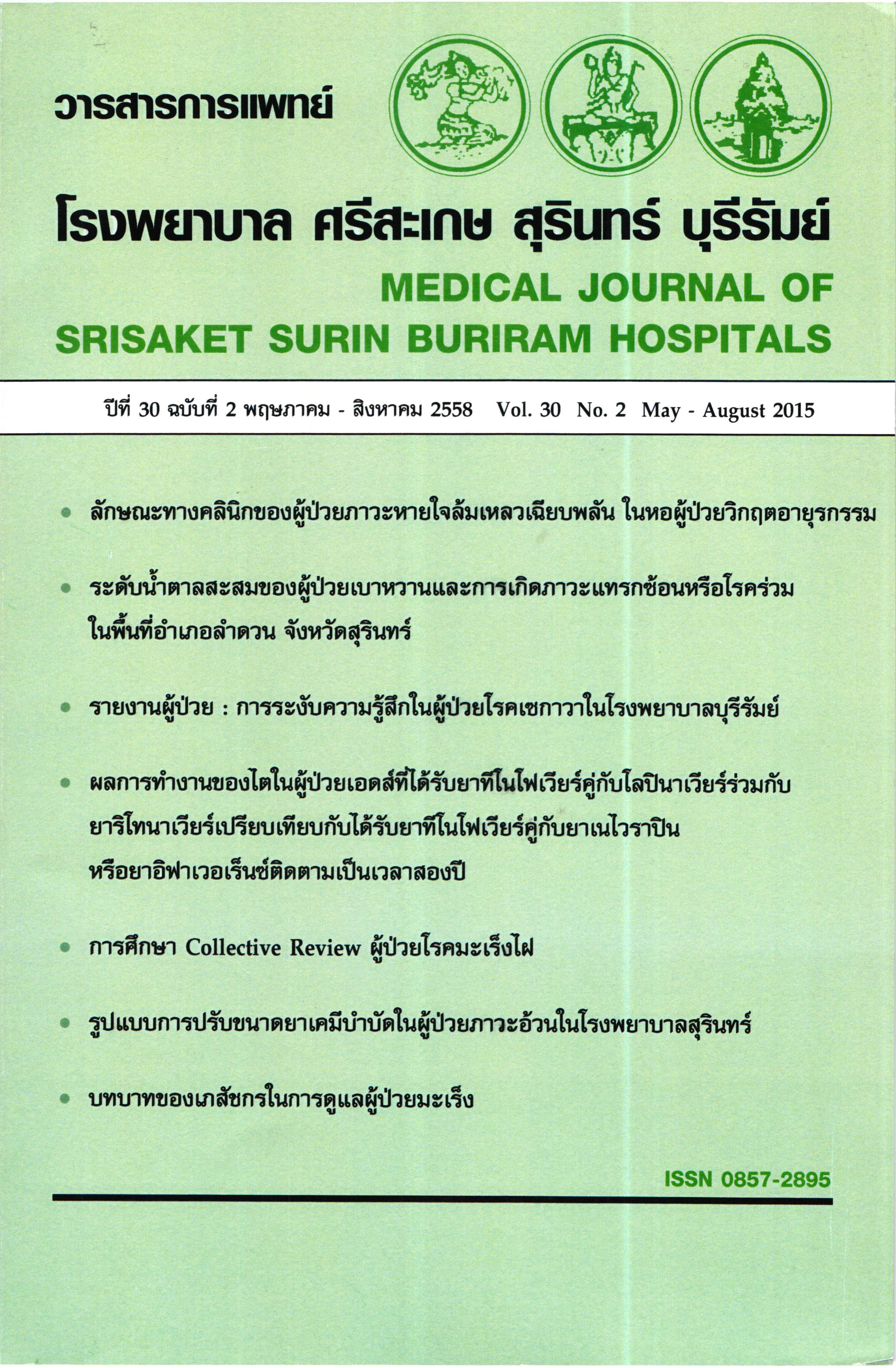รูปแบบการปรับขนาดยาเคมีบำบัดในผู้ป่วยภาวะอ้วนในโรงพยาบาลสุรินทร์
Main Article Content
บทคัดย่อ
บทนำ: ภาวะอ้วนมีความสัมพันธ์กับการเพิ่มความเสี่ยงของการเป็นมะเร็ง อย่างไรก็ตามการกำหนด
ขนาดยาเคมีบำบัดในผู้ป่วยมะเร็งที่ภาวะอ้วนมักจะได้รับยาในขนาดต่ำกว่าที่แนะนำ เนื่องจากความกังวลในอุบัติการณ์ของอาการไม่พึงประสงค์ การศึกษานี้จึงได้นำเสนอ ข้อมูลการปรับขนาดยาเคมีในผู้ป่วยมะเร็งที่มีภาวะอ้วนและอาการไม่พึงประสงค์ที่เกิดขึ้น
วัตถุประสงค์: เพื่ออธิบายรูปแบบการปรับขนาดยาเคมีบำบัดในผู้ป่วยภาวะอ้วนและอาการไม่พึงประสงค์ที่เกิดขึ้นในโรงพยาบาลสุรินทร์
รูปแบบการศึกษา: การศึกษาเชิงพรรณนาแบบภาคตัดขวาง
วิธีการศึกษา: โดยการทบทวนประวัติผู้ป่วยที่ได้รับเคมีบำบัดย้อนหลังในช่วงระหว่างวันที่ 1 มกราคม ถึง 31 ธันวาคม พ.ศ. 2557 ซึ่งได้รวบรวมข้อมูลพื้นฐานผู้ป่วย ดัชนีมวลกาย พื้นที่ผิว รวมถึงอาการไม่พึงประสงค์ที่เกิดขึ้นระหว่างการได้รับยาเคมีบำบัดเพื่อวิเคราะห์ เปรียบเทียบทางสถิติ โดยนำเสนอในรูปแบบร้อยละ ค่าเฉลี่ย ส่วนเบี่ยงเบนมาตรฐาน และสถิติเชิงอนุมานได้แก่ paired t-test, chi-square test และ fisher’s exact test
ผลการศึกษา: พบผู้ป่วยที่มีภาวะอ้วนจำนวน 43 ราย (7.9%) จากผู้ป่วยมะเร็งที่ได้รับยาเคมีบำบัด ทั้งหมด 541 ราย ในช่วงระยะเวลาทำการศึกษา ผู้ป่วยที่มีภาวะอ้วนส่วนมากเป็น เพศหญิง (40 ราย) อายุเฉลี่ย 53.5 ± 8.2 ปี และมีค่าเฉลี่ยของดัชนีมวลกายเท่ากับ 28.5 ± 4.3 kg/m2 ในผู้ป่วยที่มีภาวะอ้วนพบผู้ป่วยมะเร็งเต้านมมากที่สุด (58.1%) มีการปรับลดขนาดยาเคมีบำบัดในผู้ป่วยตาม ideal body weight จำนวน 39 ราย และมีผู้ป่วยเพียง 4 รายที่ได้รับยาเคมีบำบัดตามน้ำหนักตัวจริง ค่า relative dose intensity ของยาเคมีบำบัดเท่ากับ 0.9 ± 0.1 (p = 0.002) อาการไม่พึงประสงค์ร้ายแรงที่ใน การศึกษานี้คือภาวะโลหิตจางและ mucositis
สรุปผลการศึกษา: แม้ว่าผู้ป่วยที่มีภาวะอ้วนส่วนใหญ่จะได้รับการปรับลดขนาดยาเคมีบำบัดตาม ideal body weight แต่เมื่อเปรียบเทียบกับขนาดยาที่ควรได้รับพบว่าrelative dose intensity ไม่แตกต่างกันอย่างมีนัยสำคัญ พบอาการไม่พึงประสงค์ร้ายแรงเพียงเล็กน้อย และควร มีการศึกษาถึงประสิทธิภาพในระยะต่อไป
Article Details
เอกสารอ้างอิง
2. Pischon T, Nothlings U, Boeing H. Obesity and cancer. Proc Nutr Soc 2008:67:2:128-45.
3. Arnold M, Pandeya N, Byrnes G, Renehan AG, Stevens GA, Ezzati M. et al. Global burden of cancer attributable to high body-mass index in 2012: a population-based study. Lancet Oncol 2015;16:l:36-46.
4. Lashinger LM, Rossi EL, Hursting SD. Obesity and resistance to cancer chemotherapy: interacting roles of inflammation and metabolic dysregulation. Clin Pharmacol Ther 2014;96:4:458-63.
5. Bowers LW, Rossi EL, O'Flanagan CH, deGraffenried LA, Hursting SD. The Role of the Insulin/IGF System in Cancer: Lessons Learned from Clinical Trials and the Energy Balance-Cancer Link. Front Endocrinol 2015;6:77.
6. Khan S, Shukla S, Sinha S, Meeran SM. Role of adipokines and cytokines in obesity-associated breast cancer: therapeutic targets. Cytokine Growth Factor Rev 2013;24:6:503-13.
7. Horowitz NS, Wright AA. Impact of obesity on chemotherapy management and outcomes in women with gynecologic malignancies. Gynecol Oncol 2015;138:1:201-6.
8. Chambers P, Daniels SH, Thompson LC, Stephens RJ. Chemotherapy dose reductions in obese patients with colorectal cancer. Ann Oncol Off J Eur Soc Med Oncol ESMO 2012;23:3:748-53.
9. Hourdequin KC, Schpero WL, McKenna DR, Piazik BL, Larson RJ. Toxic effect of chemotherapy dosing using actual body weight in obese versus normal- weight patients: a systematic review and meta-analysis. Ann Oncol Off J Eur Soc Med Oncol ESMO 2013;24:12:2952-62.
10. Griggs JJ, Mangu PB, Anderson H, Balaban EP, Dignam JJ, Hryniuk WM. et al. Appropriate chemotherapy dosing for obese adult patients with cancer: American Society of Clinical Oncology clinical practice guideline. J Clin Oncol Off J Am Soc Clin Oncol 2012;30:13:1553-61.
11. Minghelli B, Nunes C, Oliveira R. Body mass index and waist circumference to define thinness, overweight and obesity in Portuguese adolescents: comparison between CDC, IOTF, WHO references. Pediatr Endocrinol Rev PER 2014;12:1:35-41.
12. Basch E, Reeve BB, Mitchell SA, Clauser SB, Minasian LM, Dueck AC. et al. Development of the National Cancer Institute's patient-reported outcomes version of the common terminology criteria for adverse events (PRO-CTCAE). J Natl Cancer Inst 2014;106:9.
13. Hansen J, stephan J-M, Freesmeier M, Bender D, Button A, Goodheart MJ. The effect of weight-based chemotherapy dosing in a cohort of gynecologic oncology patients. Gynecol Oncol 2015:138:1:154-8.
14. Rosner GL, Hargis JB, Hollis DR, Budman DR, Weiss RB, Henderson IC. et al. Relationship between toxicity and obesity in women receiving adjuvant chemotherapy for breast cancer: results from cancer and leukemia group B study 8541. J Clin Oncol Off J Am Soc Clin Oncol 1996:14:11:3000-8.
15. Au-Yeung G, Webb PM, DeFazio A, Fereday S, Bressel M, Mileshkin L. Impact of obesity on chemotherapy dosing for women with advanced stage serous ovarian cancer in the Australian Ovarian Cancer Study (AOCS). Gynecol Oncol 2014:133:1:16-22.


